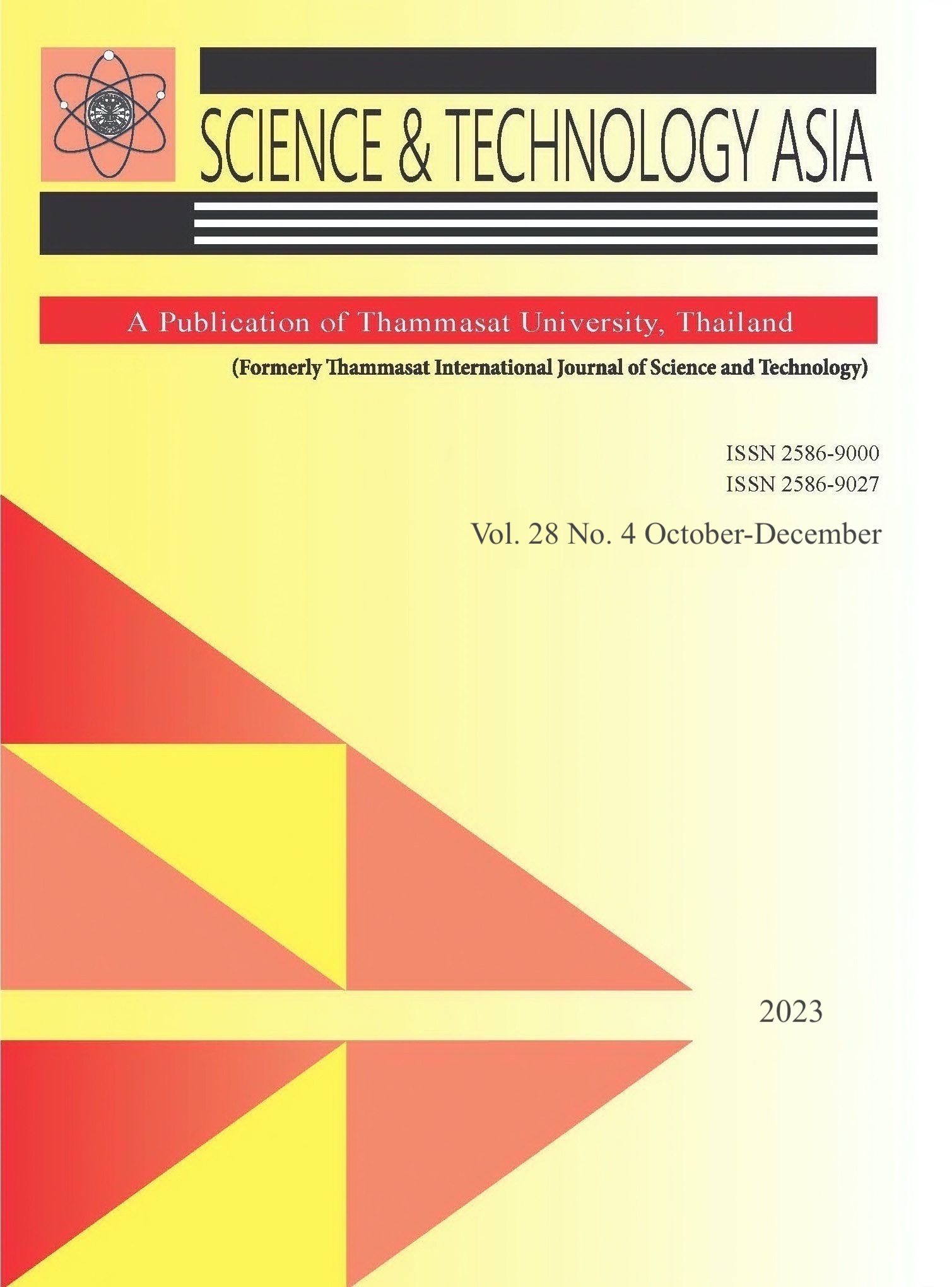Photocatalytic Activity of Gold and Silver Nanoparticles Synthesized by Using Coffee Flower Extract
Main Article Content
Abstract
In this work, silver and gold nanoparticles (AgNPs and AuNPs) were synthesized via green synthesis using coffee flower (CF) extract as a source of reducing and stabilizing agents. The concentrations of HAuCl4 and AgNO3 were varied to be 2.5, 3, and 3.5 mM and 1.5, 2, and 2.5 mM, respectively, and five dilution ratios of CF extract to water were used. CF extract was analyzed for total phenolic content and reducing power. The obtained nanoparticles were characterized by UV-visible spectrophotometer and transmission electron microscope and were used as photocatalysts in colloidal form. The results showed that total phenolic content and reducing power of the extract were equivalent to 387.23 and 377.25 mg gallic acid/L. The optimum concentration of AgNO3 was 3 mM and that of HAuCl4•3H20 was 2 mM, and the ratio of CF extract to water was 20:80. The average diameters of AgNPs and AuNPs were 35.21 and 12.18 nm, corresponding to absorbance peaks at 449 and 532 nm, respectively. The photocatalytic activities of uncoated, PEG6000 coated and alginate-coated AgNPs and AuNPs were investigated by decomposing 10 ppm methylene blue (MB) in 4 mL under UV light (250 nm, 6W). The degradation percentage after 120 min reached maximum levels of 39.6% and 35.47% by using non-coated AgNPs and alginate-coated AuNPs at loading of 0.16 mg. It was found that 0.04 mg of reused AgNPs and 0.11 mg of reused AuNPs was able to remove MB up to 11.54% and 22.90%, respectively.
Article Details

This work is licensed under a Creative Commons Attribution-NonCommercial-NoDerivatives 4.0 International License.
References
NANOTEC. ABOUT NANO TECHNOLOGY. Available from:https://www.nanotec.or.th/en/about-nanotechnology/
Mônika G.H, Clarissa H.R, Gilber R.R, Daiane D. Biogenic synthesis of gold and silver nanoparticles used in environmental applications: A review. Trends in Environmental Analytical Chemistry 2021;30:e00129.
Rania H.T. Green synthesis of silver and gold nanoparticles and their potential applications as therapeutics in cancer therapy; a review, Inorganic Chemistry Communications 2022;143:109610.
Thanawat S, Bhumin T, Duangkamol D, Panu D. Synthesis of silver nanoparticles in skim natural rubber latex at room temperature, Materials Letters 2016;168:31-5.
Harsh K, Kanchan B, Kamil K, Anu K, Eugenie N, Rachna V, Dinesh K. Flower-Based Green Synthesis of Metallic Nanoparticles: Applications beyond Fragrance. Nanomaterials 2020;10:766.
Thi M.T.N, Eun J.C, Younho S, Chi H.O, Ryo F, Hyeun J.B. Use of coffee flower as a novel resource for the production of bioactive compounds, melanoidins, and bio-sugars. Food Chemistry 2019;299:125120.
Flávia de A.P, Luzia F.E, Milton de J.F, Mariana U.M, Juliana de C.G.R, Mayara F.L, Rodrigo S, Wilton S.C. Arabica and Conilon coffee flowers: Bioactive compounds and antioxidant capacity under different processes. Food Chemistry 2021;336:127701.
Rosalind Y. KITCHEN BACKSTORIES:Coming Into Bloom-Coffee Blossom ‘Tea’. Available from: https://www.bangkok101.com/kitchenbackstories-coming-into-bloom-coffeeblossom-tea/
Muhammad B.T, Muhammas S, Muhammad S, Muhammad R. Role of Nanotechnology in Photocatalysis, Encyclopedia of Smart Materials 2022;2:578-89.
Matthew A.T, Chemical Degradation Methods for Wastes and Pollutants, Marcel Dekker, New York; 2003.
Veres, A, Rica T, Janovák L, Richardt, A, Dekány I. Silver and gold modified plasmonic TiO2 hybrid films for photocatalytic decomposition of ethanol under visible. Catalysis Today 2012;181(1):156-62.
Vanida C, Kittiya K. Preliminary Phytochemical Screening and Antioxidant Activity of Robusta Coffee Blossom. Thammasat International Journal of Science and Technology 2017;22:1.
Nichayanan M, Panu D. Coating Gold Nanoparticles Synthesized from Spent Coffee Ground Extract to Enhance Their Stability, Engineering Journal 2021;25:9.
Elisabete C.B.A.A , Ana P.C.R, Marta M, Ana M.F, Ana M.B. do R, Armando J.L.P. Effect of Phenolic Compounds on the Synthesis of Gold Nanoparticles and its Catalytic Activity in the Reduction of Nitro Compounds, Nanomaterials (Basel) 2018;8:320.


